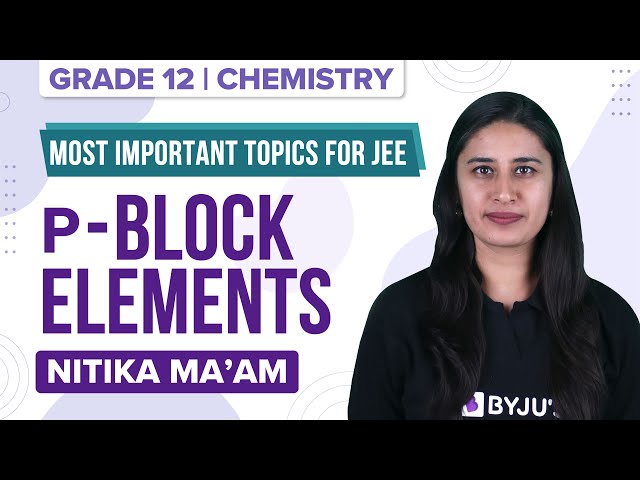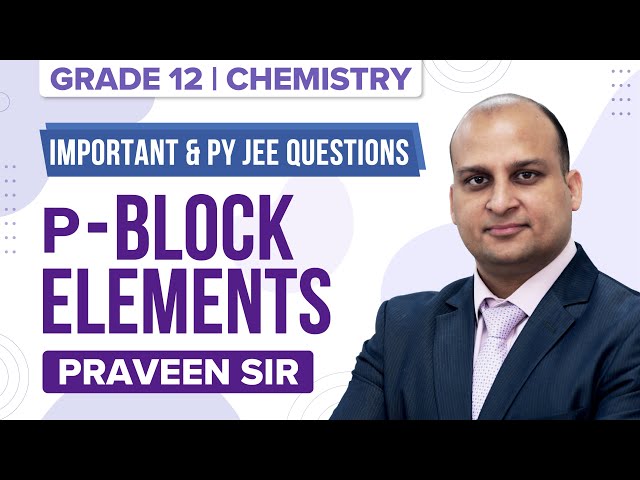p-Block Elements JEE Advanced Previous Year Questions with Solutions has been provided here to help JEE aspirants prepare well and score maximum marks in the JEE Advanced exam. Here aspirants and students likewise will find a set of questions that have appeared in the different sessions of the entrance exam in the past. In any case, this set of questions and solutions will play an important role in helping students and aspirants achieve their goal of succeeding in the exam.
As aspirants go through the questions and solutions they will further get familiar with the format of the question paper, its types and the difficulty level. Additionally, as they engage in constant practice to solve all the questions they will acquire adept problem-solving skills to tackle the different types of questions that could appear in the upcoming exam. Students or JEE aspirants can also download the p-Block Elements JEE Advanced Previous Year Questions with Solutions PDF directly from here.
Download p-Block Previous Year Solved Questions PDF
JEE Advanced Previous Year Questions on p-block
Question 1. The total number of compounds having at least one bridging oxo group among the molecules given below is:
N2O3, N2O5, P4O6, P4O7, H4P2O5, H5P3O10, H2S2O3, H2S2O5
Solution: (6)

Question 2. Based on the compounds of group 15 elements, the correct statement(s) is (are).
A. Bi2O5 is more basic than N2O5
B. NF3 is more covalent than BiF3
C. PH3 boils at a lower temperature than NH3
D. The N–N single bond is stronger than the P–P single bond
Solution: (A, B and C)
Bi2O5 is more basic than N2O5
As we go down the group, the metallic nature of the atom increases. Hence, the basic nature of its oxide increases. Hence, the given statement is true.
NF3 is more covalent than BiF3
As we go down the group, the metallic nature of the atom increases. Hence, the ionic character increases if we keep the anion constant. Thus, we can say that the given statement is true.
PH3 boils at a lower temperature than NH3
NH3 has strong intermolecular hydrogen bonding which tends to increase its boiling point compared to PH3. Hence, this statement is true.
N–N single bond is stronger than the P–P single bond
Since N is smaller in size, it faces lp-lp repulsion while forming N−N thereby reducing the effective overlap of the single bond. Thus, N−N is not stronger than P−P. Hence, the given statement is incorrect.
Question 3. The compound(s) which generate(s) N2 gas upon thermal decomposition below 300°C is (are)
A. NH4NO3
B. (NH4)2Cr2O7
C. Ba(N3)2
D. Mg3N2
Solution: (B, C)

Question 4. The option(s) with only amphoteric oxides is (are):
A. Cr2O3, BeO, SnO, SnO2
B. Cr2O3, CrO, SnO, PbO
C. NO, B2O3, PbO, SnO2
D. ZnO, Al2O3, PbO, PbO2
Solution: (A, D)
Amphoteric oxides are
ZnO, Al2O3, PbO, PbO2, Cr2O3, BeO, SnO, SnO2
NO is a neutral oxide.
CrO is a basic oxide.
B2O3 is an acidic oxide
Question 5. Among the following, the correct statement(s) is/are:
A. Al(CH3)3 has the three-centre two-electron bonds in its dimeric structure
B. Lewis acidity of BCl3 is greater than that of AlCl3
C. AlCl3 has three-centre two-electron bonds in its dimeric structure
D. BH3 has three-centre two-electron bonds in its dimeric structure
Solution: (A, B and D)
(A) Al(CH3)3 has the three – centre two-electron bonds in its dimeric structure. Structure of Al(CH3)6

(B) BCl3 is a stronger Lewis acid due to the small size of boron.
(C) AlCl3 has three-centre four-electron bonds in its dimeric structure. These bonds correspond to chlorine bridges between 2 Al atoms. Structure of AlCl3

(D) BH3 has three-centre two-electron bonds in its dimeric structure. Structure of BH2H6

Question 6. The increasing order of atomic radii of the following group 13 elements is.
A. Al < Ga < In < Tl
B. Ga < Al < In < Tl
C. Al < In < Ga < Tl
D. Al < Ga < Tl < In
Solution: (B)
The increasing order of atomic radius of group 13 elements is Ga < Al < In < Tl.
Due to the poor shielding of the d-orbital in Ga, its radius is smaller than that of Al.
Question 7. The total number of lone pairs of electrons in N2O3 is:
A. 2
B. 4
C. 8
D. 10

Solution: (C)
The total number of lone pairs of electrons in N2O3 is 8.
∴ Total number of lone pairs = 2 + 1 + 3 + 2 = 8.
Question 8. The product formed in the reaction of SOCl2with white phosphorous is:
A. PCl3
B. So2Cl2
C. SCl2
D. PoCl3
Solution: (A)
When thionyl chloride SOCl2 reacts with white phosphorus, phosphorus trichloride is produced.
P + 8SOCl2 → 4PCl3 + 4SO2 + 2S2Cl2
Question 9. Concentrated nitric acid, upon long-standing, turns yellow-brown due to the formation of NO2. State whether the given statement is true or false.
Solution: (True)
Concentrated nitric acid upon long-standing turns yellow-brown. This is due to the formation of brown coloured gas (NO2) during the process.
4HNO3 → 2H2O + 4NO2 + O2
This gas basically imparts the colour to concentrated HNO3 during long-standing.
Question 10. Bleaching powder contains a salt of an oxoacid as one of its components. The anhydride of that oxoacid is:
A. Cl2O
B. Cl2O7
C. ClO2
D. Cl2O6
Solution: (A)
Bleaching powder is Ca(OCl)Cl. Therefore, the oxoacid whose salt is present in bleaching powder is HOCl.
Anhydride of HOCl is Cl2O as;
2HOCl → Cl2O + H2O
Note: The oxidation number of the element in anhydride and oxoacid remains the same.
Also Read:
| JEE Main P Block Previous Year Questions with Solutions |
| Introduction to p-Block Elements |
| p-Block Elements |
p-Block Elements – Important Topics

p-Block Elements – Important Questions

Comments